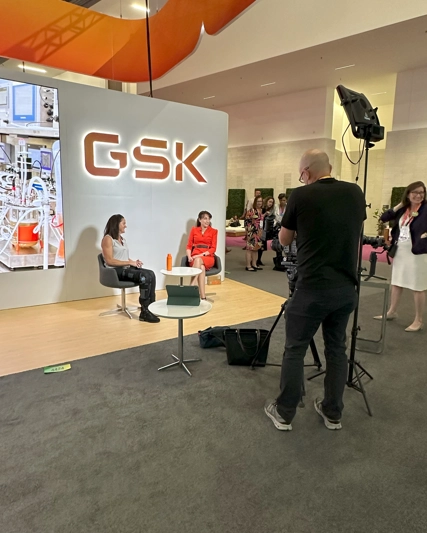GSK presents promising phase 2a data for chronic hepatitis B treatment
For media and investors only
Issued: London, UK
- Phase 2a data to be presented at The Digital International Liver Congress suggests potential of investigational drug (GSK3228836) to suppress hepatitis B virus after four weeks of treatment.
- Using pioneering antisense technology GSK’836 delivered anti-viral activity, marking a potential step forward toward the goal of assessing a functional cure for people with chronic hepatitis B.
- GSK’836 is on track to start a phase 2b programme by the end of 2020.
GSK today announced that GSK’836 (GSK3228836), an investigational antisense oligonucleotide, showed marked reductions in hepatitis B surface antigen (HBsAg) and hepatitis B virus DNA compared with placebo after four weeks treatment in people with chronic hepatitis B on stable nucleoside or nucleotide analogue (NA) therapy and in patients who were NA-naïve.
These data from the 31 patients participating in the phase 2a study will be virtually presented at The Digital International Liver Congress (ILC) 2020.[1]
Christopher Corsico, Senior Vice President Development, GSK, said: “Chronic hepatitis B affects around 260 million people globally and, despite existing treatments, can lead to nearly 900,000 deaths per year due to liver failure and liver cancer. We have observed promising early-stage results showing antiviral activity with our anti-sense oligonucleotide, a key investigational medicine in our growing infectious diseases portfolio. This marks a potential step forward toward the goal of assessing sustained functional cure for people with chronic hepatitis B.”
Chronic hepatitis B is a major global health problem caused by the hepatitis B virus. It is a long-lasting infection that occurs when the body’s immune system is unable to fight off the virus enabling it to persist in the blood and liver. Current treatment options, which include nucleoside/nucleotide analogues, can suppress but not clear the virus, so need to be taken for life.
There is a need to develop new treatments that provide a longer-lasting solution. GSK’836 uses established antisense oligonucleotide technology to suppress the virus and the viral proteins with the goal of assessing functional cure, the greatest unmet medical need in treating chronic hepatitis B. Functional cure is when the virus is not completely eliminated but is at low levels that can be controlled by the immune system without medication. It is largely defined as sustained, undetectable levels of hepatitis B virus DNA and HBsAg (surrogate markers of chronic hepatitis B) in the blood with or without generating protective antibodies after a finite course of treatment.
Professor Man-Fung Yuen, Principal Investigator and Chief of Division of Gastroenterology and Hepatology, Queen Mary Hospital, The University of Hong Kong, said: “The goal to achieve functional cure at an early age would potentially have a lower risk of liver-related complications and liver cancer. In addition, enhanced immune control associated with functional cure would potentially allow patients to be free of long-term medications. The promising results of this early-phase study warrant further investigation in efforts to achieve this goal.”
Data from the phase 2a study will be submitted for publication in a peer-reviewed scientific journal. Based on these data, GSK will progress a phase 2b clinical programme comprising studies called ‘B-Clear’, ‘B-Fine’ and ‘B-Together’ in multiple countries across Europe, Africa, North America and Asia.
The phase 2a dose-ranging study investigated GSK’836 at doses of 150mg and 300mg compared to placebo, administered by subcutaneous injection over a four-week treatment period in 31 patients. After the last treatment dose, all patients received tenofovir or entecavir (two available antivirals recommended as first-line monotherapies for chronic hepatitis B) for six months and were observed to determine if HBsAg loss was sustained. Primary endpoints included safety and tolerability. The main efficacy analysis included the change in serum HBsAg and plasma hepatitis B virus DNA from baseline to the end of the 4-week treatment period (Day 29). Other endpoints included additional antiviral parameters and pharmacokinetics.
For the selected 300mg dose of GSK’836, reductions in HBsAg were observed in NA-treated (HBeAg negative) and NA-naïve patients (HBeAg positive and negative):
- In NA-treated group (n=4), a numerically greater average [SD] reduction of -2.51 [1.57] log10 IU/ml vs. placebo -0.01 [0.04], n=2, p=0.45 was observed. Three of these patients had reductions ≥3.0 log10 IU/mL by Day 29. One additional patient discontinued at day 4 and was not included in the analysis.
- In the NA-naïve group (n=12), average [SD] reduction reached -1.56 [1.38] log10 IU/ml vs. placebo 0.00 [0.11], n=6, p=0.001. Three of these patients had reductions ≥3.0 log10 IU/mL by Day 29.
Across both treatment groups, of the six patients with HBsAg reductions >3.0 log10 IU/ml, four patients had levels falling below the limit of quantification (0.05 IU/ml). Prolonged HBsAg loss was observed in one-NA treated patient (from Day 36 to Day 113) and one NA-naïve patient (from Day 23 to Day 126).
Reductions in HBV DNA >2 log10 IU/mL were observed in 5 of 12 NA-naïve patients.
- In the NA-naïve group (n=12), average [SD] reduction reached -1.66 [1.48] log10 IU/ml vs. placebo 0.00 [0.47], n=6, p<0.001.
The most common adverse events observed in five of seventeen patients were mild to moderate injection site reactions (erythema, pain, pruritus, swelling, and/or bruising). ALT flares initiated as HBsAg depleted, which may reflect clearance of infected hepatocytes. All flares were asymptomatic and self-resolved. Safety and tolerability were acceptable to proceed to longer treatment durations. Further safety information was presented at The Digital ILC 2020.
About chronic hepatitis B
Hepatitis B is a viral infection, caused by the hepatitis B virus (HBV), in the liver that can cause both acute and chronic liver disease.[2] Chronic hepatitis B (CHB) is a long-lasting infection and occurs when the body’s immune system is unable to fight off the virus and it persists in the blood and liver.[3] It is estimated that there are 257 million people globally with CHB.[3] Even when treated, CHB can progress to liver failure and liver cancer, which results in nearly 900,000 deaths per year.[4] Around 22 million people get diagnosed and of these only 1.7 million (8%) get treated.[3]
Current treatments for CHB include nucleoside and nucleotide analogues (small molecules) and pegylated interferon. The main limitation of these antivirals is that they are suppressive but do not eliminate the virus from the hepatocytes (liver cells). Only a limited number of patients treated achieve HBsAg loss, considered the hallmark of achieving functional cure. If treatment is stopped, viral replicative activity returns requiring lifelong therapy to prevent viral rebound.
There is a need for therapeutic approaches that enable not only suppression of viral replication, but resolution of chronic HBV infection.
About GSK3228836
GSK3228836 is an investigational antisense oligonucleotide (ASO) that has been designed to specifically recognise the messenger RNA (mRNA) that the Hepatitis B virus uses to make viral antigens (disease-causing protein) in infected cells (hepatocytes) in the liver. It helps to destroy the mRNA by recruiting the liver’s own enzymes to digest it to an inactive form. The subsequent reduction in the levels of the mRNA results in a decrease in the production of viral antigen (HBsAg) by the hepatocytes, which can be measured by a drop in the antigen levels in the circulating blood.
GSK3228836 (previously known as ‘ISIS 505358 or IONIS-HBVRX’) was discovered by and jointly developed with Ionis Pharmaceuticals. GSK3228836 is one of the ASO HBV programme assets in-licensed by GSK from Ionis Pharmaceuticals in August 2019. GSK is now fully responsible for all development, regulatory and commercialisation activities and costs.
About GSK
GSK is a science-led global healthcare company with a special purpose: to help people do more, feel better, live longer. For further information please visit www.gsk.com/about-us.
Cautionary statement regarding forward-looking statements
GSK cautions investors that any forward-looking statements or projections made by GSK, including those made in this announcement, are subject to risks and uncertainties that may cause actual results to differ materially from those projected. Such factors include, but are not limited to, those described under Item 3.D "Risk Factors" in the company's Annual Report on Form 20-F for 2019 and as set out in GSK’s “Principal risks and uncertainties” section of the Q2 Results and any impacts of the COVID-19 pandemic.
References:
[1] Yuen MF et al. Hepatitis B virus (HBV) surface antigen (HBsAg) inhibition with ISIS 505358 in chronic hepatitis B (CHB) patients on stable nucleos(t)ide analogue (NA) regimen and in NA -naive CHB patients: phase 2a, randomized, double-blind, placebo-controlled study. Abstract No. AS067. The Digital International Liver Congress 2020.
[2] Hepatitis B Fact sheet. World Health Organization. https://www.who.int/news-room/fact-sheets/detail/hepatitis-b.Updated on July 18, 2019. Accessed on November 29, 2019
[3] Global Hepatitis Report 2017. World Health Organization. https://www.who.int/hepatitis/publications/global-hepatitis-report2017/en/ Accessed on November 29, 2019
[4] Global Health Estimates 2015: deaths by cause, age, sex, by country and by region, 2000–2015. Geneva: World Health Organization. 2016; Accessed on Jan 28, 2020


